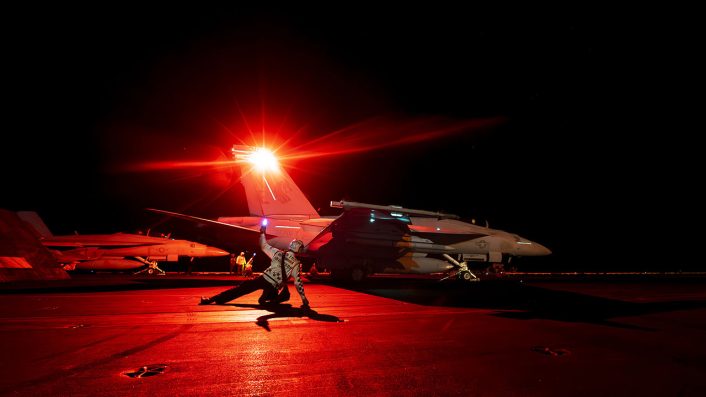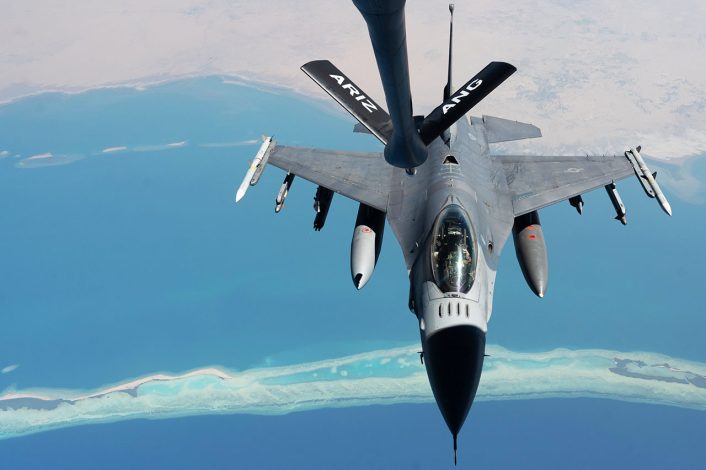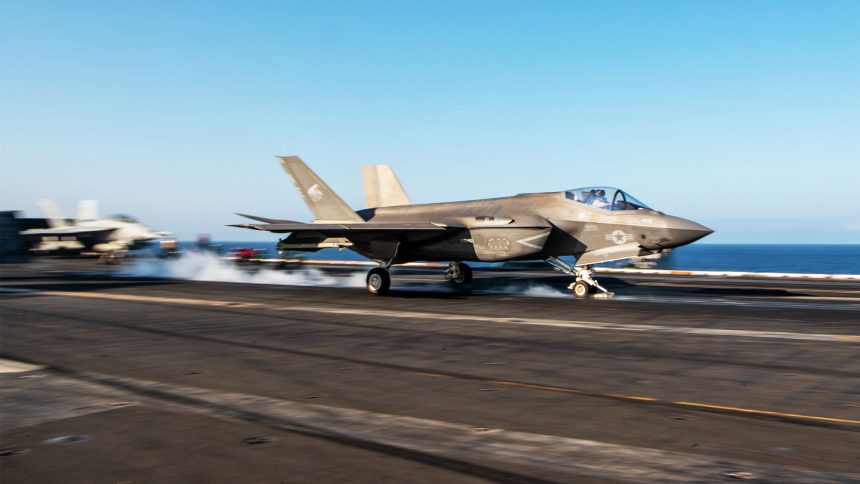U.S. officials speaking to The New York Times said Houthi rebels ‘nearly struck’ U.S. F-16s and an F-35 within the first 30 days of Operation Rough Rider.
A month into Operation Rough Rider, an intensified campaign of airstrikes against Houthi targets in Yemen, President Trump wanted to see results. Targeting Houthi air defence sites and leadership, this opening phase was only the first part of U.S. Central Command (CENTCOM) head General Michael Kurilla’s eight to ten month plan.
Yet with the loss of no fewer than seven MQ-9 Reaper unmanned aerial vehicles (UAV) to hostile fire, as well as close calls with manned fighter aircraft, the U.S. had clearly been unable to secure aerial superiority. $1 billion of operational costs had been spent in the space of a single month, not including the two F/A-18 Super Hornets that had been completely lost during the operation.

According to the U.S. military, a number of leading Houthi figures had been killed during Rough Rider, and over 1,000 targets had been struck. Stockpiles of advanced weapons, including standoff precision missiles, were dwindling, causing deep concern in the military that the U.S. would lose the strategic depth it needed for potential future operations in the Indo-Pacific. Valuable B-2 Spirit stealth bombers had been deployed in relatively large numbers, and at significant cost, to bolster the two aircraft carriers and various CENTCOM bases already contributing to the operation.
Controversy brewed in Washington D.C. as Secretary of Defence Pete Hegseth was criticised across the political divides for his use of the Signal messaging app to discuss active operations, mistakenly including an uncleared reporter within the group chat. Although no harm to personnel seems to have resulted from this lapse in operational security, a number of personnel were injured in the aforementioned F/A-18 incidents. Along with near hits scored by Houthi surface to air weapons against U.S. F-16s and F-35s, this brought home the extraordinary risk being taken by frontline personnel and underscored the very real potential for loss of American lives.
“Several American F-16s and an F-35 fighter jet were nearly struck by Houthi air defenses, making real the possibility of American casualties, multiple U.S. officials said” according to The New York Times.

By May 5, 2025, just under two months after the operation began, the White House ordered an immediate halt to further missions. A ceasefire deal, mediated by Oman, had been agreed between the U.S. and the Houthis barring each from attacks on the other. Further Houthi attacks have taken place against non-U.S. targets, including Israel – it’s unclear how the ceasefire deal treats these incidents, or if it does at all.
The B-2s at Diego Garcia were soon allowed to return home to Whiteman AFB, likely requiring some upkeep of their delicate radar absorbent surfaces upon their return after such a long period deployed. Only four B-2 Shelter Systems (B2SS) are deployed at Diego Garcia – not enough to permanently house all six aircraft in the detachment. Satellite images revealed the aircraft spent extended periods outside exposed to the elements in the isolated oceanic outpost.
First OSINT I’ve seen confirming some of the B-2s have left Diego Garcia, after over a month’s deployment.
The island’s climate is not ideal for the aircraft. There was always a ticking clock to how long they would stay (tho timing right after the Houthi ceasefire is notable). https://t.co/qjGaiJdsZT
— Gregory Brew (@gbrew24) May 11, 2025
Replacing the B-2s, four B-52H Stratofortresses had arrived in the days before their departure. The much more vulnerable B-52s would have to rely on long-range strike weapons like the AGM-158 Joint Air-to-Surface Standoff Missile (JASSM) should they be tasked against the Houthis (if the ceasefire breaks down), or if, as some predict, they have been forward deployed as a signal to Iran.
🚨update🚨
🇺🇸NSF Diego Garcia🇺🇸
The other 2x B-52s have arrived at Diego Garcia.
Quite a bit of firepower on the small atoll in the Indian Ocean.
6x B-2 stealth bomber
4x B-52 long range bomber
4-6x KC-135
1x C-5 or C-17
src📷: @USGSLandsat
8 May 2025
Given 15m📷resolution,… https://t.co/HA4d7X3fAu pic.twitter.com/ga3ZwOzxU6
— MT Anderson (@MT_Anderson) May 8, 2025
How could the Houthis have targeted an F-35?
It is difficult to know for sure what the exact makeup of the Houthis’ air defences is. We have evidence that, via Iran, the group has access to both infrared (IR) and radar guided missiles. These include purpose built designs as well as repurposed air-to-air missiles of Soviet designs such as the R-27, R-73, and R-77.
In intercepted Iranian weapons shipments to the Yemeni rebel group, the U.S. has documented new ‘loitering SAMs’ with imaging infrared (IIR) sensors. These are widely known as 358s, though Houthis have been noted referring to them as Saqr-1. IIR seekers are the most advanced type of IR seeker heads, and are employed by the Western AIM-9X Sidewinder and AIM-132 ASRAAM. Instead of looking purely for heat sources, the seeker is essentially a thermal camera. Computers within the missile can then analyse the image provided and distinguish the shapes of aircraft, missiles etc, as well as reject infrared countermeasures like flares.
Notable Iran acknowledges ‘358’ Surface-to-Air Missile for the first time – a weapon it has supplied to Yemen Houthi since at least 2019https://t.co/vaZyXmAZF8 pic.twitter.com/PPBunpSKYH
— Joseph Dempsey (@JosephHDempsey) September 20, 2023
Infrared guidance is usually preferred for smaller systems, including man portable air defence systems (MANPADS), while larger systems with greater range and altitude capabilities will often utilise radar guidance. Operating radar guided missiles in an environment with an active suppression of enemy air defences (SEAD) mission ongoing is risky, as the activation of a search or target acquisition radar is easily detectable and would likely result in a counter-launch of an anti-radiation missile. EA-18G Growlers, operating from the USS Harry S. Truman and USS Carl Vinson, are specialists in this mission and additionally carry advanced jammers to render such radar systems less effective or ineffective.
The moment an American MQ-9 reaper drone was shot down by the Houthis in Yemen using a missile from the KUB (Sa-6) SAM system. pic.twitter.com/O9q6s3MCJO
— AMK Mapping 🇳🇿 (@AMK_Mapping_) December 29, 2024
While the F-35’s advanced radar cross-section reduction measures render it difficult to detect with radar, the aircraft still produces a significant infrared signature. This vulnerability is known to designers, and reducing the IR signature is a key part of aircraft design – however, there is only so much reduction that can be applied to the most powerful turbofan engine ever fitted to a U.S. fighter.
It must always be remembered that the use of stealth aircraft is an attempt to increase survivability, and not to guarantee it. Stealth aircraft will eventually be lost to enemy fire – indeed, one F-117 Nighthawk famously already was.
The reference to multiple F-16s having been involved in near hits from Houthi air defences, compared to just a single F-35, could be a demonstration of how the latter offers improved combat survivability. Although, it could also be down to differing missions on different sorties as well as simple luck.
We don’t know how the pilots in each circumstance were able to avoid the missiles. Both the F-16 and F-35 are equipped with a number of electronic and physical countermeasures to protect against infrared and radar guided missiles. Most famously, flares can be employed for infrared missiles, and chaff for radar guided missiles. Towed radar decoys offer an additional measure against radar guided missiles, as does internal electronic warfare technology. Newer radar decoys, like Leonardo’s BriteCloud, are being assessed for frontline deployment.









